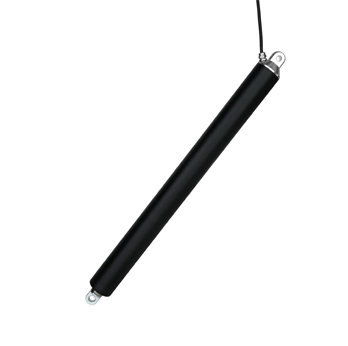Transform your home into a smart, futuristic space with 12V linear actuators—compact, affordable, and perfect for DIY enthusiasts. These versatile devices can automate everything from hidden compartments to climate control systems. Below are 10 creative projects to inspire your next home automation upgrade, complete with practical tips and technical insights.

1. Hidden Bookshelf Door
Problem: Boring, static bookshelves.
Solution: Create a secret passageway!
How it works: Install a 12V linear actuator to pivot or slide a bookshelf, revealing a hidden room or storage space.
Components Needed: Actuator, steel brackets, remote control or motion sensor.
Why 12V? Low voltage ensures safety and quiet operation, ideal for residential use.
Pro Tip: Use a magnetic latch to keep the door securely closed when not in motion.
2. Automated Pet Feeder
Problem: Forgetting to feed your pets.
Solution: A motorized feeder on a schedule.
How it works: Use a 12V actuator to lift a hinged lid or push a food dispenser tray. Pair with a timer or smartphone app.
Components Needed: Actuator, Arduino/Raspberry Pi, food container, programmable relay.
Why 12V? Safe for household pets and compatible with battery backups.
3. Motorized TV Lift Cabinet
Problem: TVs cluttering your living room.
Solution: A TV that rises from a cabinet or footboard.
How it works: Mount actuators vertically inside furniture to lift the TV at the push of a button.
Components Needed: 2–4 actuators (depending on TV weight), wooden frame, wireless remote.
Why 12V? Smooth, silent motion avoids disrupting movie nights.
4. Adjustable Kitchen Countertops
Problem: Fixed countertops for different users.
Solution: Create height-adjustable workspaces.
How it works: Install actuators under the countertop to raise/lower it for cooking, baking, or wheelchair accessibility.
Components Needed: Heavy-duty actuators (500–1,000 lb capacity), steel supports, hand-held controller.
Why 12V? Energy-efficient and easy to integrate with under-cabinet wiring.
5. Smart Security Gate Latch
Problem: Manually locking gates.
Solution: Automate entry points for security.
How it works: Use an actuator to remotely lock/unlock a gate latch. Add a camera or keypad for access control.
Components Needed: IP67-rated actuator, weatherproof enclosure, smart hub (e.g., Alexa, SmartThings).
Why 12V? Weather-resistant models handle rain and snow without voltage risks.
6. Motorized Window Openers
Problem: Stuffy rooms or forgotten open windows.
Solution: Automate ventilation based on temperature.
How it works: Actuators push/pull windows open or closed. Sync with smart thermostats (e.g., Nest, Ecobee).
Components Needed: 12V actuator, temperature sensor, limit switches.
Why 12V? Safe for damp environments and low power draw.
7. Fold-Down Murphy Bed
Problem: Wasted space in small rooms.
Solution: A bed that folds into the wall.
How it works: Actuators smoothly lower and raise the bed frame. Add safety sensors to stop motion if obstructions are detected.
Components Needed: 2–3 actuators, plywood frame, safety laser sensor.
Why 12V? Quiet operation won’t wake light sleepers.
8. Self-Watering Vertical Garden
Problem: Over- or under-watering plants.
Solution: Automated plant care.
How it works: Actuators tilt planters or control watering nozzles on a schedule.
Components Needed: Light-duty actuators, moisture sensors, drip irrigation kit.
Why 12V? Solar-compatible for eco-friendly setups.
9. Motorized Closet Organizers
Problem: Cluttered, hard-to-reach shelves.
Solution: Rotating racks or sliding drawers.
How it works: Actuators push/pull clothing racks or shoe shelves into view.
Components Needed: Compact actuators, rails/pulleys, voice-control module (e.g., Alexa).
Why 12V? Compact size fits tight spaces.
10. Retractable Outdoor Awnings
Problem: Sun or rain ruining patio time.
Solution: Auto-deploying shade.
How it works: Actuators extend/retract awning fabric based on weather sensors or a remote.
Components Needed: IP68-rated actuators, waterproof fabric, wind sensor (to retract in storms).
Why 12V? Handles outdoor conditions without complex wiring.
Tools & Materials You’ll Need
Safety Tips
Always fuse your 12V power lines to prevent overloads.
Test actuator motion without load before final installation.
Use limit switches to avoid over-extending strokes.
Secure loose wiring with zip ties or conduit.
Why 12V Actuators Rule DIY Home Automation
Safety: Low voltage reduces fire/electrical hazards.
Affordability: Cheaper than industrial 24V/120V systems.
Compatibility: Works with car batteries, solar panels, or standard power supplies.
Quiet Operation: Ideal for bedrooms/living spaces.
Ready to Automate?
Whether you’re hiding a secret room or simplifying daily chores, 12 volt electric linear actuators offer endless possibilities. Start small (like the pet feeder) and scale up to advanced projects as you gain confidence. Share your creations online—you might inspire the next DIY revolution!
 DDTG-16 Micro Tubular Linear Actuator
DDTG-16 Micro Tubular Linear Actuator
 DDTG-28 Micro Tubular Linear Actuator
DDTG-28 Micro Tubular Linear Actuator
 DDTG-38 Micro Tubular Linear Actuator
DDTG-38 Micro Tubular Linear Actuator













